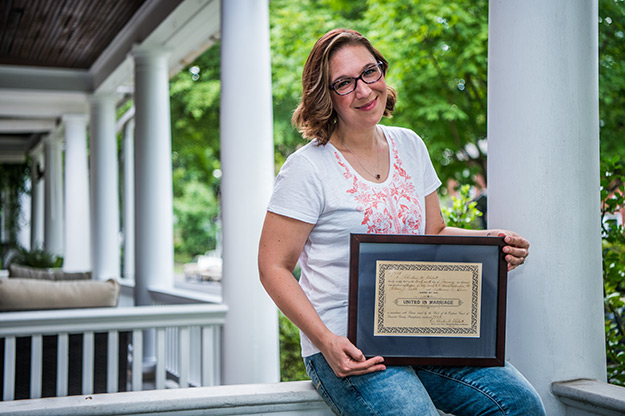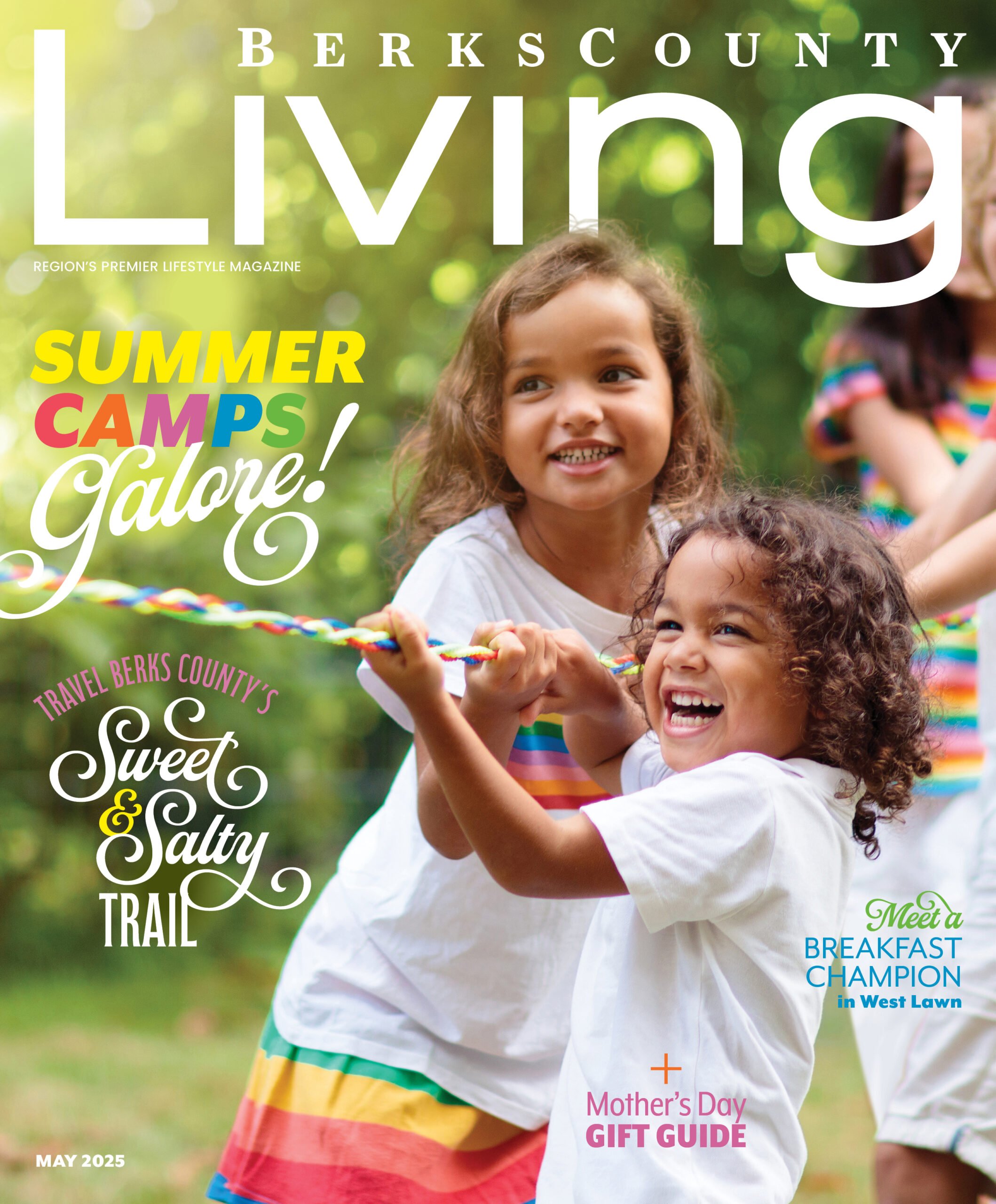Most everyone has something in his or her home that is considered an heirloom.
The venerable Merriam-Webster Dictionary's simple definition of heirloom is: “a valuable object that is owned by a family for many years and passed from one generation to another.” Indeed, it is that passage of object(s) from generation to generation that separates heirlooms from simple collectibles.
The rich diversity of Greater Reading’s population and its 300-plus-year heritage pretty much ensures that many of us possess an heirloom or two.
Read on for two heirloom tales from Berks residents: one that documents a shared lineage with an indisputable Hollywood icon and the other that dishes pride in a West Virginia town where the family’s roots run deep.
Crystal clear
It’s not the reflection of celluloid figures but rather the reflective nature of crystal-clear dishes that puts stars in the eyes of Regina Rineheimer and Leigh Ann Sobjak, a mother and daughter duo who reside in Lower Heidelberg Township and Shillington, respectively.
But their roots are still firmly planted in Moundsville, West Virginia. They moved to Berks some 22 years ago when Leigh Ann was just a girl.
Regina and Leigh Ann brought along their memories and pieces of home. Among the most precious ones are unique glass items manufactured by the former Fostoria Glass Company in Moundsville, about 20 miles from Wheeling.
“I was born in 1964, and the company was in its heyday in the 1950s, but as I grew up, I was surrounded by Fostoria,” Regina says. The company was established in the early 1900s in Ohio but relocated to Moundsville, where it was a major regional employer for decades. Its doors closed in 1986, but its popularity extended to the White House; administrations from Dwight D. Eisenhower to Ronald Reagan placed orders.
Sitting in her large dining room, Regina is still surrounded by Fostoria, and she and Leigh Ann happily and sentimentally bask in its reflective illumination coming from a large lighted hutch.
A pattern here…and there
They note pattern names that run the gamut from nearly A to Z, pointing out some of the eclectic pieces passed down through the family or gifted to Regina in her youth. During her teens she was somewhat of an ambassador for Fostoria; as West Virginia’s 4H representative, she attended a national convention held in Chicago and was asked to bring something that represented her state. Fostoria provided little square stubs of glass in a number of colors for her to distribute.
“They were what we called nubs, and they were in every color: ruby red, amber, cobalt blue, pink and clear,” she says. “I would hand them out and say: ‘This is from my hometown.’”
The women’s collection brightens the dining room table. There are various patterns, including a pink one commonly called Depression Glass and a striking, almost asymmetrical azure early 1980s pattern called Viking, one of the company’s last.
Family ties
The duo’s affection for the clear American pattern is tied to Regina’s former mother-in-law and Leigh Ann’s grandmother, Beverly Whitelatch, who, at age 90, still sets every holiday dinner table in her Moundsville home with a complete set.
Ruth Chrislip, Leigh Ann’s maternal grandmother and Regina’s mom, also has her own Fostoria Glass treasure trove, but it contains many colorful and mixed-pattern pieces, reflecting her creative and artistic nature. “There are dishes all over the place,” Regina says with a smile.
But it was Grandmother Whitelatch’s presentation of the American pattern Regina, and especially Leigh Ann, would strive to emulate. The distinctive clear raised geometric pattern lends itself to a variety of table settings and can easily reflect the different occasions from Valentine’s Day, to Easter, to summer holidays, to Thanksgiving and Christmas.
“Everything has its place; it’s all very proper, reflecting her English heritage,” says Leigh Ann of Grandmother Whitelatch's collection. “It was a more elaborate setup. It felt fancy, and we always knew the holidays were coming. As a teen and growing up, I loved it, and [I] still do.”
Linking the past to the future
The duo began adding to the few American pattern pieces Regina already had. One, perhaps prophetically gifted early on, is a frame bearing a picture of baby Leigh Ann.
Because she knew another family member was in line to inherit Grandmother Whitelatch’s complete set, Leigh Ann began surfing Internet sites for finds. Other family members like Grandmother Chrislip would scour local flea markets and yard sales.
In June 2017, Regina will be a part of the ultimate search for American pattern pieces. As a member of the Fostoria Glass Society of America Inc., she’ll be attending the annual auction in Moundsville where pieces are up for purchase or barter.
Because Regina has the bigger hutch and most family dinners are held in the Rinehimer home, the collection is housed there. Leigh Ann’s ultimate goal is to gather enough items for 10 place settings like her grandmother’s, complete with everything: dinner and salad plates, a variety of dessert ware, and a number of glasses and goblets. And, of course, there are still assorted side and serving dishes to acquire along with vases, and candlesticks; the list is seemingly endless.
As Regina and Leigh Ann explain their devotion to the pattern, pieces grab the light and disperse rays onto the walls.
Storied pieces
“Each piece has its own story; you can’t acquire it all at once,” says Leigh Ann. “You wonder what kind of stories people shared over it. You make your own memories. Right here, just with these pieces in front of me, there are stories of maybe six different houses.”
Someday Leigh Ann will be serving her guests meals on the American pattern in the Shillington house she shares with her husband Stefan. And the dinnerware won’t be the only historical part of the meal: the house belonged to Stefan’s grandparents, and the dining room set, a white-and-gold mid-60s classic, was passed down from Leigh Ann’s step grandparents.
Regina hopes the couple won’t reserve the dinnerware for just the holidays or special occasions.
“My mom would say: ‘Don’t put it away; every day is special. Don’t save it for a rainy day; every day is a gift.’”

Tying the knot back when
On a late summer morning in Wyomissing, Angie Dietrich and her husband Jeff take a break from exercise to savor the slight breeze wafting across the front porch of their brick duplex. Their little dog Wilson is by their sides, making sure passers-by know who’s in charge of the block.
At first glance, this millennial couple may seem unlikely sentimentalists. Indeed, East Reading-raised Jeff readily admits that’s not his thing, but Angie is another story.
Angie, born and raised in Lancaster County, counts among her most prized possessions her great grandparents’ wedding certificate. The century-old document, carefully framed and preserved, officially notes the Jan. 29, 1913, marriage of William J. Gable to Catherine C. Klem in Columbia, Lancaster County. It is proudly displayed in the Dietrichs’ living room.
“It’s more than 100 years old and I still marvel at it,” Angie says. “Something like that is almost like an intimate piece of history…this is their marriage…this is the day they decided to spend the rest of their lives together. And I have it.”
A decade and a half ago, when Angie was in her early 20s, she discovered the certificate folded in a dresser in the house her great-grandparents occupied at 532 N. Second St. in Columbia. The cleaning out of the house and its nearly 100 years of accumulated belongings fell to Angie, her mother Clarissa Weeks of Mount Joy, and a few other relatives.
William and Catherine had four children: Mary, James, Roy (also known as Tom), and Clara. Only Clara, Angie’s grandmother, would marry. The other three siblings remained stolidly single and shared their parents’ home throughout their adult lives.
Generous memories
Angie joyfully remembers the house and its occupants. Without children of their own, the great uncles and aunt lavished attention on their sister’s children and grandchildren.
“I’d give almost anything for another Sunday dinner with them,” Angie recalls wistfully.
The siblings were generous in good and bad times. There was always “a little something” for them at birthdays and graduations. When her parents divorced, they provided moral and financial support.
“They were always there for us,” she says. And her great Aunt Mary, especially close to her mom, helped Angie and the others in her generation with education and other needs as well. “She gave me a check one time and I thought it was for $500,” Angie says, “but when I got to the bank to sign it, it was for $5,000. I was floored, but she wouldn’t take ‘no’ for an answer when I protested.”
Indeed, her great uncles and aunt remained stalwart Columbia citizens where their grandparents settled. The family church, Holy Trinity Catholic Church, was the beneficiary of great Uncle Tom’s entire estate. Her Aunt Mary contributed and made fasnachts there until age rendered her unable.
The Hollywood connection
Her great Uncle Jim – there’s no forgetting him. Generous like his siblings, he had something else priceless going for him: movie star looks courtesy of his cousin who had made it big in Hollywood, the one and only Clark Gable.
Yes, William J. Gable’s brother was Clark Gable’s father. Which makes (actually, made) Clark Gable Angie Dietrich’s third cousin.
The Gables, with their German, Irish and Swiss- German mixed ancestry, apparently originally settled in Berks and Lancaster counties. Sometime in the mid 19th century, Angie said one side of the Gable family moved to Ohio (where Clark was born in Cadiz just west of the Pennsylvania line) and became farmers while the other Gables stayed in Lancaster County, becoming butchers. Indeed, her great grandparents’ home was attached to the family butcher shop.
Angie notes that a great-great aunt was about the only member of the Pennsylvania Gables to keep in touch with the California Gables (the family moved there when Clark made the big time) and would travel to visit Clark’s dad, William Henry “Will” Gable. If you are following all these Gables, yes, it appears that Angie’s great-grandfather was William J. Gable and his brother (Clark’s father) was William H. Gable. Confused yet? Don’t be, because the important person here, Angie, isn’t.
She, her mom and their siblings all have a sense of pride in the Gable background. If one looks closely enough at Angie, there is more than a passing resemblance to the flash of Clark Gable’s smile.
While Angie does not have family photos of Clark, she does have multiple copies of Gone with the Wind, the book whose movie incarnation of Rhett Butler made Gable an icon.
“I do like history,” she says. “I’ll pick up old copies of Gone with the Wind at flea markets. I’ve read the book multiple times, and I can’t count the number of times I’ve seen the movie.”
A new "star"
While the couple has no children of their own, their little dog Wilson seems to have at least spiritually attached to his human third – or is it fourth? – cousin’s appetite for fame. Named after Ronald Wilson Reagan, the 40th U.S. president and film colony buddy of Clark, Wilson has achieved his own contemporary popularity of sorts: he is a blossoming Instagram star.
“He has 17,900 followers,” says Angie, who decks him out in bowties and other costumes and often features him accompanied by a small herd of stuffed animals. “Running his Instagram is coming up on being a part-time job,” she admits.
While the name William was prominent among the Gables (indeed, the actor’s legal name was William Clark Gable), there does not appear to be another Clark in the mix. But Angie’s mom Clarissa paid tribute to the movie icon with one of her first pets – a dog named Rhett. Now, imagine if he was on Instagram!
By Donna Reed | Photos by John A. Secoges, Secoges Photographics















